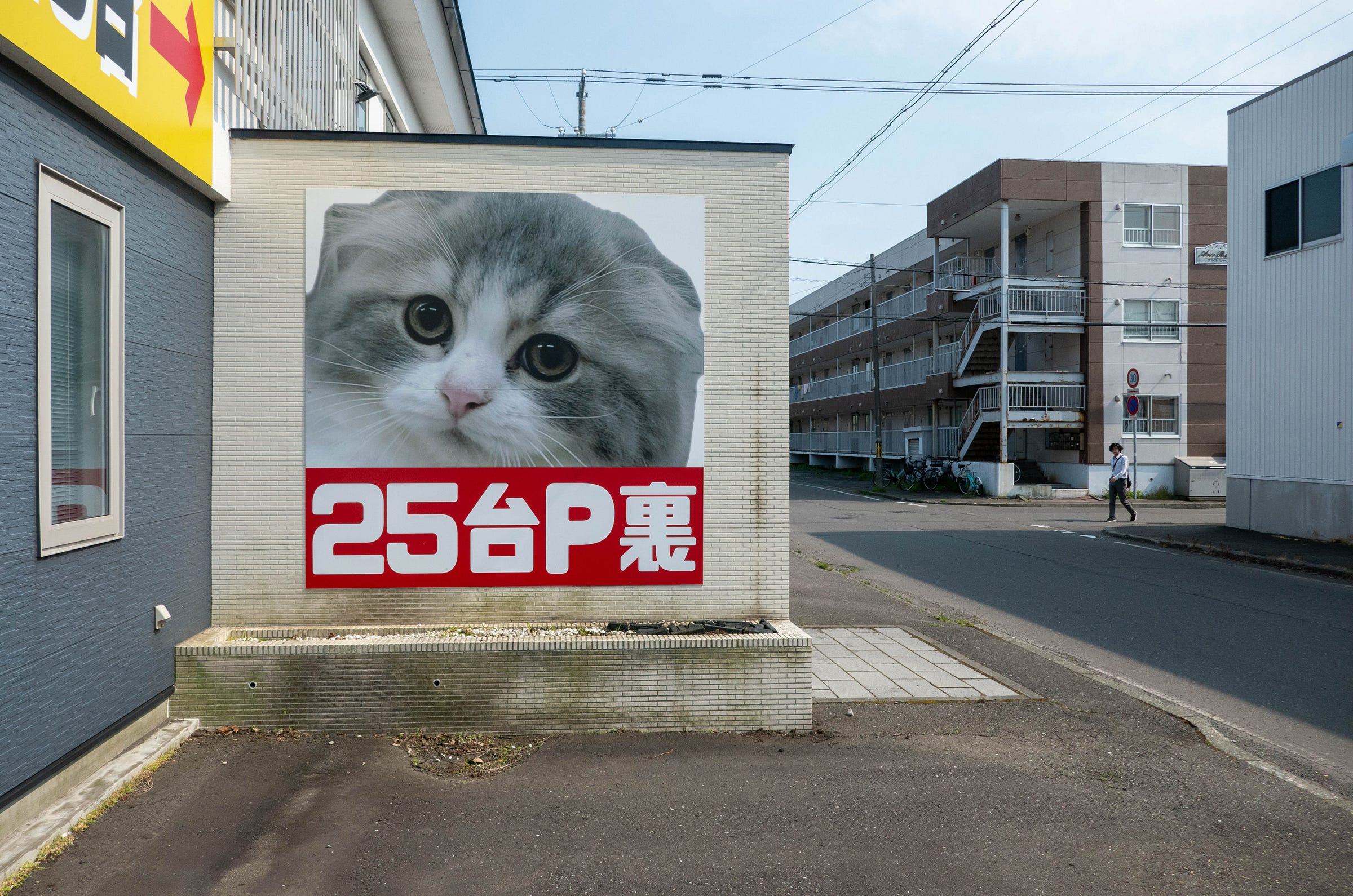In praise of Japanese small, Hokkaido as Wisconsin, and pachinko memories
A few thoughts from a few weeks of travel
(This is my fourth long walk in Japan. The prior nine posts from those trips: From Tokyo to Takasaki, A retreat to Niigata, A pointless little Japan story, From Akashina to Fuji, Walking Fuji, Playgrounds and manhole covers, From Fukuoka to Nagasaki, Burnout in Japan and last weeks post, Walking Hokkaido)
Hokkaido as Wisconsin
I chose Hokkaido because it was cooler, expecting to find few differences from the rest of Japan. During my prior long walks across three different regions, I'd found Japan to be defined by its uniformity to an extent that it can feel claustrophobic and oppressive, as if you're a character in a cheap cartoon with a repeating background of a handful of scenes, some idyllic, but most identical blocky urban landscapes cycling past in monotonous repetition.
That is because Japan has the same geography, culture, and policy across the overwhelming majority of its length. Japan itself, as a physical entity, is a uniform mix of the wild and cultivated: A juxtaposition of impossibly steep mountain ranges and active volcanoes, next to broad flat alluvial plains holding dense sprawling cities and highly curated fields of crops, all hemmed in by a coastline that’s always present, but rarely seen1, barricaded behind brutal concrete barriers. Zoom in on any built region and that uniformity continues, with what exactly can be constructed, and where, determined by the National Ministry of Land, Infrastructure, Transport and Tourism, with little leeway given to local variations. Zoom in even further, and you also find a uniformity in the citizens. While it has become somewhat hip to suggest Japan’s culture and people are actually very diverse, the reality is absolutely not. Japan is mono-cultural, mono-ethnic, and that is one of the attributes that defines it, relative to the rest of the world2.
That uniformity, from the highest to the lowest levels, is what gives Japan its shared vision of a common good, and allows it to build things, like an extensive public transit system, that other countries cannot, and to live as closely together as they do, without constant external policing. Density requires an unacknowledged understanding of proper behavior, if it can be pulled off without heavy outside monitoring, because people regulate themselves.
Japan has fewer cultural character types, and those that exist are more alike at both the surface level of behavior and the deeper level of identity. I’m borrowing an idea here from an earlier post of mine, where I suggest that,
“… cultures, like a video game, provide their citizens with a limited array of characters to play, each with different strengths and weaknesses. The selection and popularity of these characters changes with time, mostly driven by the same viral/random mathematical process as any large scale interconnected system … but the array on offer is mostly, but not exclusively, determined by elites….”
Hokkaido however is different, at least initially in appearance, and that shouldn't be too surprising, given it’s a far northern island with a distinct history, having only been colonized and settled and built late (1900s), with inspiration and assistance from Americans.
It also has more space, and consequently feels far more American than the rest of Japan, almost as if you are in a warped Wisconsin. That's especially true outside of the larger cities, where you find yourself in windy flat fields of potatoes and corn, as well as smaller towns with neighborhoods of sloped roof homes with garages, constructed to deal with the heaps of snow each gets.
The pictures below could come from the US Midwest, with the exception of the last one, with the single rice field, a minority crop in Hokkaido.
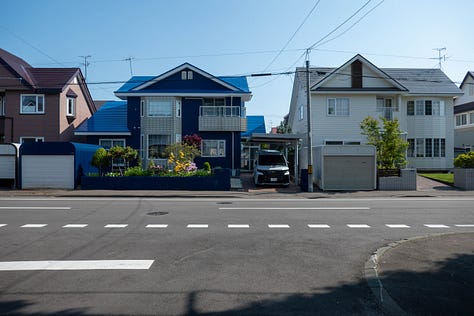
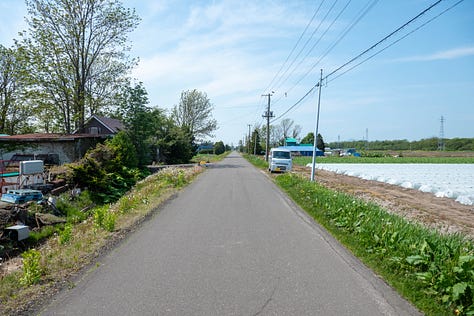
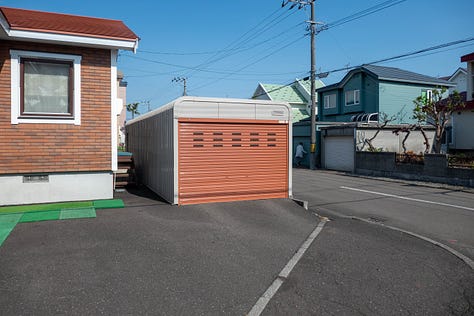

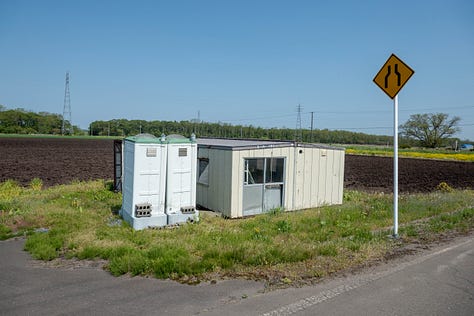
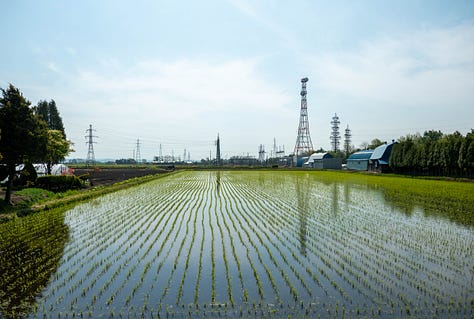
My walk took me through these interior fields for two days, but the majority of the time was spent along the coast. I’d started at the water’s edge northwest of Sapporo, and ended at the harbor town of Muroran, although I did cheat with a train boost for most of the last sixty miles, because it also was very Americanized. I’d found Japan's version of US Route 1, which did little for me other than remind me that the world’s cities are remarkably similar looking, and that means every place has commercial sprawl that comes with modern life3, and Hokkaido has more than most places, especially on the narrow strip of towns on its south coast.
Despite that, I enjoyed myself for most of the route because Japan is a country that puts pedestrians at the top of the walker, cyclist, and driver triad, so there is almost always a sidewalk, and you're rarely forced to tightrope along the shoulder of a busy road worried about being slapped by a side-view mirror or engulfed in exhaust, or are so far from a bus or train line that you might feel stranded. Yet, I also found little inspiration. The path I'd chosen was functional, but drab, with the beauty of the mountains too far away and wild to tackle, and the ocean almost entirely hidden behind the tsunami barriers.
The entire route looked like it was a seventy-thirty mix of Japan and the US, especially the smaller cities I stayed in, like Chitose, Tomakomai, and Muroran, which share a fading industrial town melancholy with the US Rust Belt, right down to franchise-heavy strips, empty shops, and hulking factories, although in Japan most plants still belch smoke, rather than being left to sink into the weeds, a significant difference.
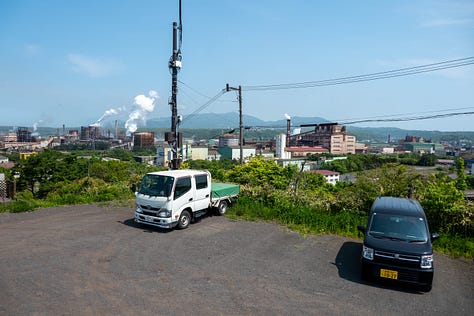
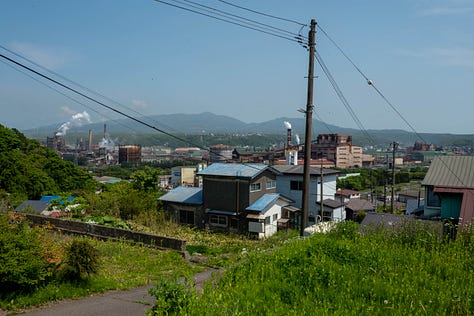

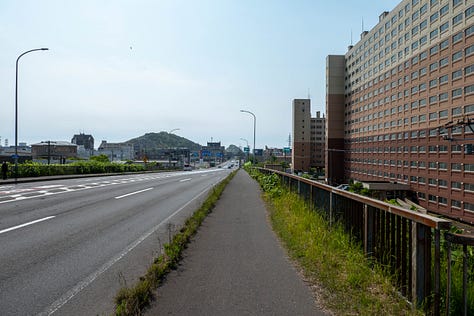
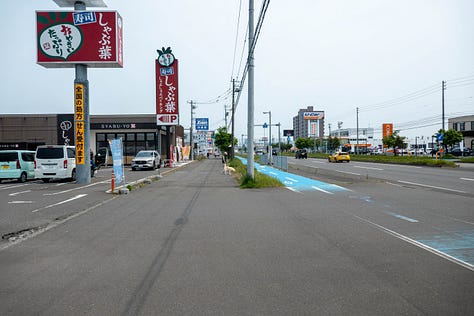
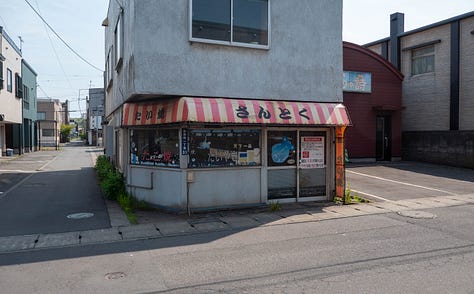
In retrospect I should have taken my own advice and focused on these smaller cities, all of which I found surprisingly charming and relaxing, because they have eighty-five percent of what Sapporo does, but without the ravenous packs of Chinese tourists loading up on bags of sweets. They are also more knowable, simply because they are less overwhelming, and so you can get a better sense of Japanese life, and individuals stand out from the crowd.
While Hokkaido might look slightly different from the rest of Japan, it is still very much Japanese. There is still a shared building code, and a respected notion of the public good, and that means it is safe, clean, and efficient, and each night, no matter where you are, there are plenty of options on where to eat that are not simply franchises of national chains.
These small businesses, which are often run out of someone's home, owned by a family who are also the only employees, are what distinguishes Japan from all other developed nations, making life in it a notch above the rest. While the most obvious of these are restaurants (izakayas, monjayaki-yas, soba-yas, etc.), others are focused on specialized crafts, or small services.
The plethora of these businesses is a result of Japan's embrace of mixed-use zoning, meaning, you can have commercial and residential on the same street, and in the same building, so shops flourish all over, not simply on high streets or in distant malls. That localized distribution, as I’ve written before, is also the secret sauce to Japan’s walkability.
They also flourish because Japanese craftsmanship is exceptional, and so customers are willing to try an unknown place because it will likely result in a singularly remarkable experience, rather than a disaster. This is the opposite of America, where the big chains originally marketed their brands on reliability over quality, essentially saying "Sure we may offer up bland mediocrity, but we're safe unlike those scary mom and pop places where who knows what awfulness lurks."
As a foreigner who doesn’t speak Japanese, there is a problem that comes with using these smaller businesses, which is getting the X arms. What is that? It’s when you walk into an otherwise empty restaurant and the staff looks at you, sees problems because you don't speak the language, don't know the unwritten rules, might not accept what they serve you, and might go online and trash the place, and so your downside is bigger than your upside, and so their risk assessment of the unknown (you) is nope, I don't want to deal with this, and they run towards you with a big smile and cross their arms into an X. Fully booked for the night, despite all the empty seats, and despite there being nobody else outside on the streets possibly looking to eat.
When I get the X arms, and I got them almost once a night on this trip, I'm not upset, because I understand what they're doing. For the Japanese system to work, they need public trust, and that means hundreds to thousands of unwritten rules that regulate behavior and more likely than not I don't know them and so I might be a problem, and they can’t have that because their informal reputation is almost all of their marketing and they don’t want to risk that, so they instead go with a "judging a book by its cover" ethos, which is more often correct than not.




